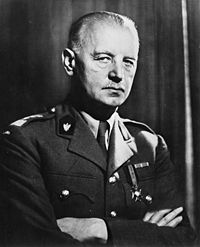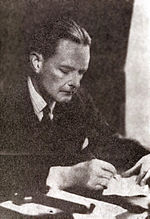Polish Institute and Sikorski Museum
 Polish Institute and Skorski Museum, main entrance | |
| Formation | 2 May 1945 |
|---|---|
| Type | Learned society |
| Registration no. | 312168 |
| Legal status | Registered charity |
| Purpose | Archival, educational, historical, and museological |
| Headquarters | 20 Prince's Gate, London, SW7 1PT |
| Services | Research and publications, lectures and events, heritage conservation, and exhibitions |
Chairman | Danuta Bildziuk |
Head of Archives | Andrzej Suchcitz |
| Website | www.pism.org.uk |
The Polish Institute and Sikorski Museum (
Origins

It was created immediately on the conclusion of the
Activities
The institute has conserved historical records, including witness records from the
Study Trust of the Polish Underground State

Founded in 1948, by a group of veterans led by general Tadeusz Bór-Komorowski the Polish Underground Movement (1939–1945) Study Trust – Studium Polski Podziemnej w Londynie, known as the Studium, amalgamated with the institute in 1988. Although it lost its separate legal status, it was granted internal autonomy to carry out its own research and publications from its base in Ealing.[8]
Governance
The institute and Sikorski Museum is divided into the following departments and sections:
- Archives
- Museum, including the Photographic Archive, the Film Archive and the Sound Archive
- Reference Library
- Administration
- Publications
- Regimental Colours Fund
The institute is governed by a Council which elects the Executive Committee from among its members who run the day-to-day business of the institute. The chairman heads the Council and Executive Committee. Membership consists of honorary members (nominated by the AGM), full members chosen by the Council, life members by single donation and annual members.

Since its inception the institute has had eight chairmen:
- Prof. Stanisław StrońskiPhD (1945–1951)
- Lt. Gen. Prof. Marian Kukiel PhD (1951-c.1965)
- Count Edward Raczyński PhD (c.1965–1976)
- Stanisław Leśniowski MSc (1977–1979)
- Capt. Ryszard Dembiński(1979–2004)
- Krzysztof Barbarski CEng (2004–2022)
- Krzysztof deBerg (2022 -2023 )
- Danuta Bildzuik (2023 - )
See also
- History of Poland (1939–45)
- Polish government in exile
- Poles in the United Kingdom
- Polish Library in Paris
- Polish Museum, Rapperswil
- Institute of National Remembrance
References
- ^ Historic England, "20 Prince's Gate (1265482)", National Heritage List for England, retrieved 14 July 2016
- ^ 'Princes Gate and Princes Gardens: the Freake Estate, Development by C.J. Freake', in Survey of London: Volume 45, Knightsbridge, ed. John Greenacombe (London, 2000), pp. 191–205. British History Online http://www.british-history.ac.uk/survey-london/vol45/pp191-205 [accessed 28 February 2020]. See plate 90.
- ISBN 0-7185-1211-1
- ISBN 978-0786455362.
- S2CID 163543066.
- PAP (2011). "Zdjęcia z Londynu w cyfrowym archiwum Karty"(in Polish). Retrieved 27 February 2020. Polish press agency report of the digitalisation of five thousand war-time photographs from the Institute's archive in London.
- ^ Time Out listing of a 2008 exhibition at the Institute of retrieved photographs from a skip in Brixton, accessed 27 February 2020. Archived 27 February 2020 at the Wayback Machine
- ^ Buliczowa, Kazimiera (1985). Studium Polski Podziemnej w Londynie: Informator 1947–1984 (in Polish). London: Studium Polski Podziemnej w Londynie. Digitized on 1 Dec 2006 by the University of Michigan
Bibliography
- "Documents on Polish-Soviet Relations, 1939–1945", General Sikorski Historical Institute, London: Heinemann. 1967.
- Milewski, Waclaw. Suchcitz, Andrzej. Gorczycki, Andrzej. (Eds.) "Guide to the Archives of the Polish Institute and Sikorski Museum". 1985
- Suchcitz, Andrzej. O Instytucie Polskim i Muzeum im. gen. Sikorskiego w Londynie, Pamiętnik Literacki, tom XIII, Londyn 1988 – About the Polish Institute and Sikorski Museum in London, a Memoire(in Polish).
- Suchcitz, Andrzej. Powstanie Instytutu Historycznego im gen. Sikorskiego, [w:] Idea Europy i Polska w XIX-XX wieku, Towarzystwo Przyjaciół Ossolineum, Wrocław 1999 – The creation of the Historical Sikorski Institute in "The Idea of Europe and Poland in the 19th and 20th centuries". Association of the Friends of the Ossolineum. (in Polish).
- Orr, Aileen (2012). Wojtek the Bear: Polish War Hero. Edinburgh: Birlinn Publishers. ISBN 978-1-84341-057-7.
Gallery
-
A turret gun from a Polish 7TP light tank which was used against the invading Germans in September 1939. It was later employed by the Germans in France and recovered during the allied invasion of western Europe in 1944.
-
A memorial to the Polish pilots who fought in World War 2
-
An exhibit about the Polish contribution to the Battle of Britain
-
Remains of the 178th German plane shot down by the Polish303 squadron during the Battle of Britain
-
A memorial to the thousands of Polish men, women and childrendeported and starved to death on Russian soil during and after World War 2
-
Original manuscripts by Polish poet Adam Mickiewicz
-
Regimental colours
-
The Władysław Anders room
-
A bust of Władysław Anders
-
A souvenir from the Battle of Monte Cassino
-
A sculpture of Wojtek the soldier bear by David Harding
-
A plaque commemorating the 50th anniversary of the Warsaw Uprising and Operation Tempest
-
A bust of Jan Sobieski
-
A Polish hussar helmet from the 17th century
-
The emblem of the1st Polish Armoured Division
51°30′5″N 0°10′24″W / 51.50139°N 0.17333°W
External links
- The Sikorski Institute's Official website
- Website of the Study Trust of the Polish Underground State, available in English, German and Polish.
- The National Archives listing with location map of the Sikorski Institute.
















